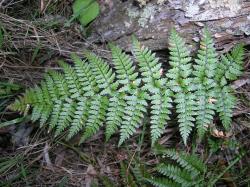- = Hypopeltis Michx., Fl. Bor.-Amer. [Michaux] 2, 226 (1803)
Terrestrial ferns, evergreen or occasionally marcescent. Rhizomes erect, scaly. Rhizome scales non-clathrate, ovate or narrowly ovate, margins entire or fimbriate, attached at base, concolorous or bicolorous, pale brown to black-brown. Fronds monomorphic, sometimes bulbiferous. Stipes and rachises scaly, adaxially sulcate. Laminae 1–3-pinnate (NZ), or 4-pinnnate (not NZ), herbaceous or coriaceous, scaly. Veins free. Sori round, borne on abaxial surface, away from the margin, in 1 row either side of midrib; indusia round, peltate. Spores monolete; perispores tuberculate or cristate, often reticulate or fenestrate, rarely minutely echinate on the surface.
A genus of c. 500 species included in the subfamily Dryopteridoideae (PPG 1 2016).
Polystichum is considered to be monophyletic (Le Péchon et al. 2016) and sister to Cyrtomium. The polystichoid ferns are sister to the dryopteroid ferns, the latter comprising Arachniodes and Dryopteris (Liu et al. 2016).
Allan (1961) recognised four indigenous species in New Zealand – P. cystostegia, P. richardii, P. sylvaticum (as silvaticum) and P. vestitum. However, Perrie et al. (2003a) showed that plants previously referred to P. richardii comprised an allo-octoploid complex with two tetraploid species, P. oculatum and P. wawranum, and an octoploid species, P. neozelandicum.
Two naturalised species, P. proliferum and P. setiferum, and one casual species, P. lentum, were recorded by Brownsey (1981). A second casual species, P. polyblepharum, was reported by Heenan et al. (2004).
| 1 | Fronds bearing bulbils | 2 |
| Fronds lacking bulbils | 4 | |
| 2 | Fronds with numerous bulbils, borne along the rachis at junctions with the primary pinnae | setiferum |
| Fronds with one or a few bulbils, borne near the apex of the rachis | 3 | |
| 3 | Proximal primary pinnae bearing several stalked secondary pinnae | proliferum |
| Proximal primary pinnae sometimes divided to the costa, but never bearing more than one stalked secondary pinna | lentum | |
| 4 | Indusia with conspicuous black centres, or, if only tiny dark centres, scales at stipe/rachis junction with colourless, fimbriate margins at their bases | 5 |
| Indusia uniformly pale brown, or absent; scales at stipe/rachis junction with entire or ciliate margins | 7 | |
| 5 | Scales at stipe/rachis junction appearing hair-like to the naked eye (<130 μm wide); indusia often lacking an obvious dark centre | wawranum |
| Scales at stipe/rachis junction obviously scale-like to the naked eye (>130 μm wide); indusia always with an obvious dark centre | 6 | |
| 6 | Scales at stipe/rachis junction ovate or broadly ovate, >750 μm wide (and usually >1000 μm wide); spores 36–48 μm long, 27–36 μm wide | oculatum |
| Scales at stipe/rachis junction ovate or narrowly ovate, <650 μm wide; spores 46–58 μm long, 36–45 μm wide | neozelandicum | |
| 7 | Scales at stipe/rachis junction concolorous | 8 |
| Scales at stipe/rachis junction bicolorous, with shiny dark centres and pale margins | 9 | |
| 8 | Stipe and rachis scales entire; indusia markedly convex; plants of alpine regions | cystostegia |
| Stipe and rachis scales irregularly toothed; indusia ± flat; naturalised plants of urban areas | polyblepharum | |
| 9 | Indusia absent; costae of primary pinnae with narrow wings | sylvaticum |
| Indusia present; costae of primary pinnae lacking wings | vestitum |
In New Zealand, species of Polystichum are recognised by their terrestrial habit, erect rhizomes, 1–3-pinnate fronds, abundant and sometimes bicolorous scales, and round sori protected by round indusia. Three naturalised species are bulbiferous, unlike any other species of Dryopteridaceae in New Zealand. The spores are tuberculate or cristate, often with complex fenestration and reticulation (Large & Braggins 1991).
Polystichum is widespread in north and south temperate regions, and in montane to alpine regions of the warm temperate and tropical zones. The centres of diversity are in southern Asia, and in Central and South America (Zhang & Barrington 2013); 208 species in China (Zhang & Barrington 2013), 22 in Africa and Indian Ocean islands (Roux 2009), four in Australia (Jones 1998), perhaps five in the south Pacific, and three in Hawai‘i (Palmer 2003). Ten species in New Zealand; five endemic, one indigenous, and four naturalised or casual.
| Category | Number |
|---|---|
| Indigenous (Endemic) | 5 |
| Indigenous (Non-endemic) | 1 |
| Exotic: Fully Naturalised | 3 |
| Exotic: Casual | 1 |
| Total | 10 |
Hybridisation is common amongst the indigenous species of Polystichum in New Zealand. Seven different combinations were recorded by Perrie et al. (2003a, 2003b). Plants of hybrid origin can be identified by their abnormally formed spores, but determining parentage depends on morphology and field observations of what species were growing in the immediate vicinity of the putative hybrid.
The base chromosome number in Polystichum is x = 41 (Kramer 1990).




